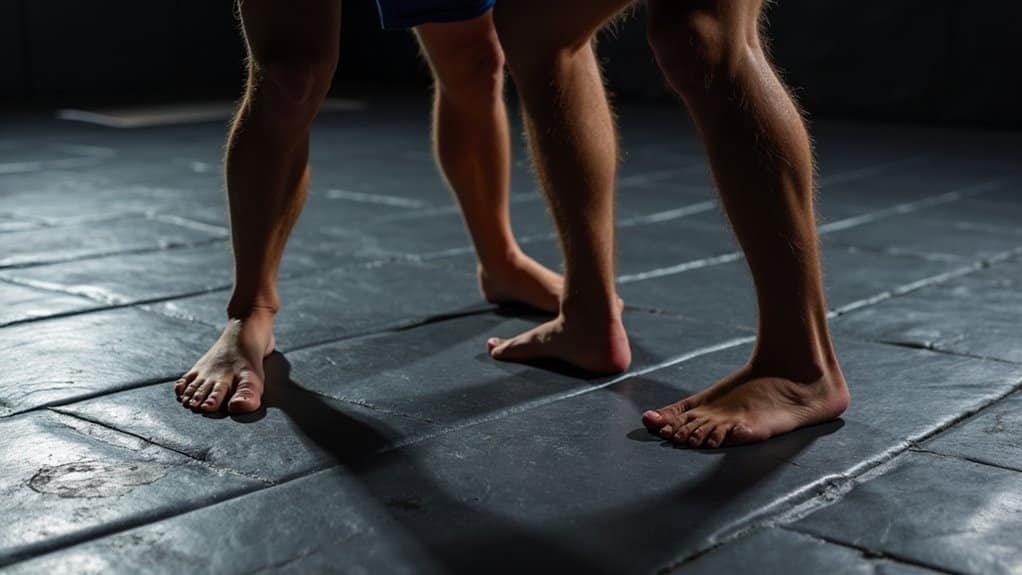Mastering sweeps from the bottom position requires fighters to combine precise timing with fundamental off-balancing principles. Effective techniques include hip bump sweeps from closed guard, De La Riva guard sweeps using leverage mechanics, and waiter sweeps from deep half guard. Success depends on maintaining strong grips, recognizing when opponents shift weight distribution, and avoiding telegraphed movements that invite counters. Strategic integration with submission threats creates multiple offensive pathways while minimizing time spent in disadvantageous positions. Understanding these technical foundations enables you to transform defensive scenarios into championship-winning opportunities.

While standing fighters often dominate highlight reels with spectacular knockouts, the ground game frequently determines championship outcomes in mixed martial arts. Mastering sweep techniques from the bottom position transforms defensive scenarios into offensive opportunities, creating pathways to dominant positions that align with MMA scoring criteria.
The foundation of effective sweeping rests on establishing strong grips while simultaneously implementing off-balancing principles known as kuzushi. Hip bump sweeps exemplify this concept, utilizing closed guard positioning and hip motion to destabilize opponents. Fighters must secure collar or wrist control before generating the explosive hip movement that creates the necessary leverage for positional reversal.
De La Riva guard offers multiple sweeping options that capitalize on hooking and leverage mechanics. The sit-up sweep employs the guard’s natural structure to generate momentum, while the wrestle-up variation forces opponents to post their hands, creating takedown opportunities. Both techniques require precise leg positioning to maintain guard integrity throughout the shift. This versatile guard position has been used for decades and provides dynamic opportunities for fighters at all levels.
Deep half guard presents unique sweeping opportunities through the waiter sweep, which uses leg control and outward foot rotation to remove an opponent’s base. This technique demonstrates how proper body positioning can maximize force transfer, enabling smaller fighters to effectively sweep larger opponents through mechanical advantage rather than relying solely on raw strength. The defensive ground position requires fighters to use their legs effectively while maintaining control from their back.
Timing is the critical element that separates successful sweeps from failed attempts. Executing sweeps as opponents distribute weight or attempt guard passes dramatically increases success rates. Telegraphed movements, conversely, become susceptible to direct counters and allow opponents to establish stronger passing positions. When grasping the opponent’s shin, avoid using thumbs to maintain a stronger grip that prevents easy escape during the sweeping motion.
Strategic integration of sweeps with submission threats multiplies offensive possibilities. Combining hip bump sweeps with guillotine or kimura attacks forces opponents into defensive reactions that open additional sweeping windows. De La Riva and deep half positions often transition into leg locks or back takes, creating a continuous attack flow that keeps opponents guessing.
MMA’s striking component adds complexity to sweeping techniques. Fighters must protect themselves during shifts while maintaining offensive pressure. Poor grip security or inadequate follow-through exposes practitioners to strikes and allows opponents to recover posture or base.
Mastery requires systematic training approaches that condition techniques for real-fight situations. Repetitive drilling with resistance builds timing and technical execution, while positional sparring from various guard positions develops real-time application skills. Live rolling against diverse body types improves adaptability, and video analysis of professional bouts reveals high-level setup patterns.
Effective sweeping minimizes time spent in the bottom position while creating scramble opportunities that can reset unfavorable situations. This fundamental skill set transforms guard players from defensive grapplers into offensive threats capable of controlling fight tempo and positioning.
Frequently Asked Questions
How Long Does It Typically Take to Master Sweep Techniques in MMA?
Sweep mastery in MMA typically requires 3-6 months of dedicated training, three times weekly, to master basic techniques such as scissor sweeps.
Intermediate-level sweeps with complex setups require 6-18 months of training against skilled opponents.
Complete mastery spans two or more years, often extending throughout a competitive career.
Athletes with prior grappling experience tend to progress faster, while recreational practitioners require longer timelines.
Quality coaching, consistent sparring partners, and cross-training significantly accelerate development.
What Are the Most Common Mistakes Beginners Make When Attempting Sweeps?
Beginners typically rush sweeps without proper setup, attempting techniques when opponents maintain strong base and posture. They rely heavily on arm strength rather than coordinating their entire body, often failing to establish a controlling grip beforehand.
Poor timing compounds these issues—either hesitating at vital moments or forcing sweeps prematurely.
Additionally, beginners often neglect follow-through after successful sweeps, allowing opponents to recover instead of shifting immediately into dominant positions.
Which Body Types Are Naturally Better Suited for Executing Sweep Techniques?
Taller fighters with longer limbs excel at sweeps that require leverage and distance control, such as elevator and butterfly variations.
Compact, muscular builds dominate explosive techniques demanding high strength-to-weight ratios.
Flexible athletes adapt quickly during scrambles and execute angle-based sweeps effectively.
However, foot sweeps work across all body types without specific physical requirements.
Most sweep techniques can be modified to leverage individual strengths through adjusted grips, angles, and timing.
How Do You Prevent Opponents From Countering Your Sweep Attempts?
Fighters prevent sweep counters by securing dominant grips on sleeves or collars before initiating attacks.
They time sweeps when opponents’ bases are compromised, using feints to disrupt defensive timing. Blocking the opponent’s posting arm eliminates counter leverage, while maintaining active leg hooks disrupts balance.
Creating angles rather than sweeping straight back complicates counter timing, and shifting smoothly between attacks keeps opponents defensive.
What’s the Best Way to Practice Sweeps Without a Training Partner?
Shadow drilling forms the foundation of solo sweep practice. Athletes perform movements in the air while visualizing their opponent’s positioning, activating neural pathways that mirror the live application.
Grappling dummies and medicine balls simulate resistance for realistic weight-shift training. Hip bridges and core exercises build explosive power, which is essential for effective sweep execution.
Recording sessions allows technical analysis, while structured progression tracking guarantees measurable improvement in timing, fluidity, and mechanical precision.

